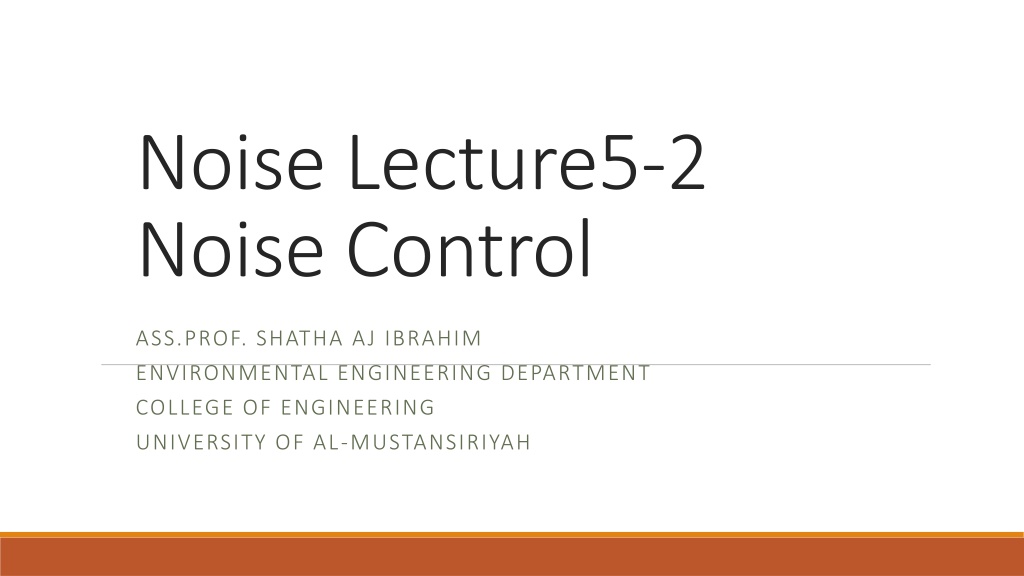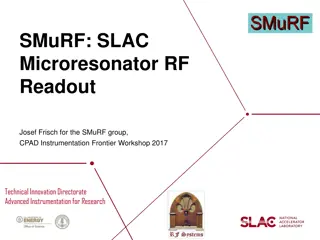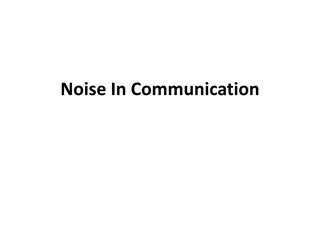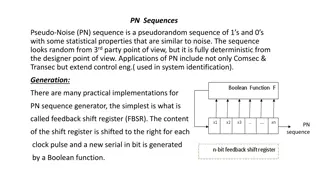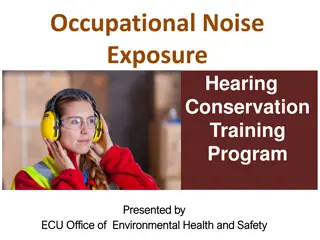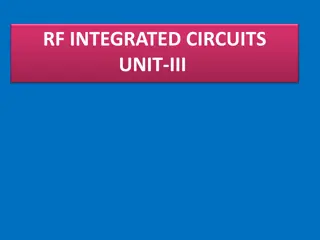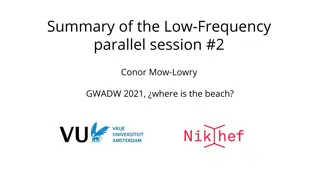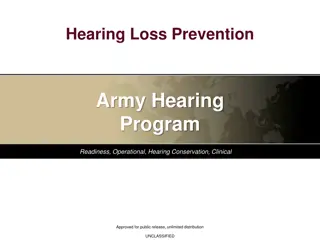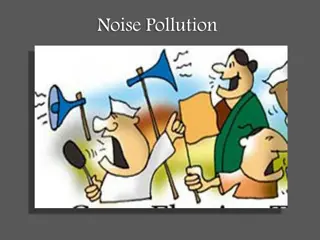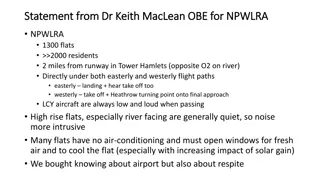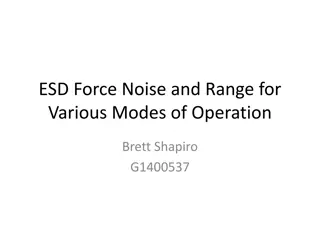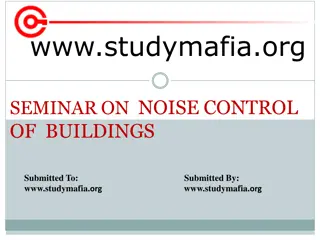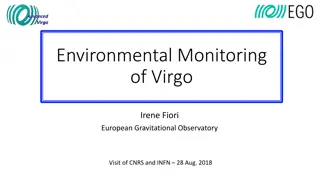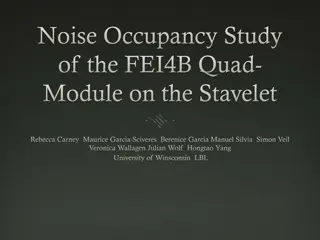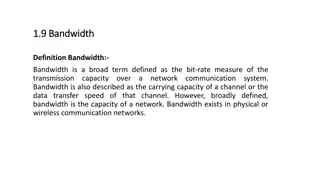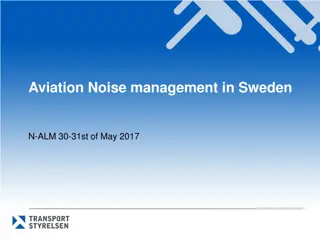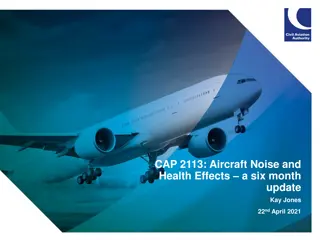Understanding Noise Control Methods in Environmental Engineering
Explore the concepts of noise control in environmental engineering, focusing on mufflers, reactive mufflers, and noise control in the transmission path. Learn about absorptive and reactive mufflers, their principles, and applications. Discover how barriers and panels can effectively reduce noise transmission. Understand the importance of selecting the most suitable technique based on various factors to minimize noise pollution effectively.
Download Presentation

Please find below an Image/Link to download the presentation.
The content on the website is provided AS IS for your information and personal use only. It may not be sold, licensed, or shared on other websites without obtaining consent from the author. Download presentation by click this link. If you encounter any issues during the download, it is possible that the publisher has removed the file from their server.
E N D
Presentation Transcript
Noise Lecture5-2 Noise Control ASS.PROF. SHATHA AJ IBRAHIM ENVIRONMENTAL ENGINEERING DEPARTMENT COLLEGE OF ENGINEERING UNIVERSITY OF AL-MUSTANSIRIYAH
6-Provide mufflers (silencer): the devices can be classified into 2 fundamental groups: Absorptive muffler (is one whose noise reduction is determined mainly by the presence of fibrous or porous materials, which absorb the sound). The attenuation produced, in dB per meter run of duct, depends on , the sound absorption coefficient of the lining material and the ratio of perimeter to cross sectional area of the duct (P/S).
This figure shows the arrangement of sound absorbing materials in a splitter silencer with 3 airways. Reactive muffler (is one whose noise reduction is determined mainly by geometry. It is shaped to reflect or expand the sound waves with resultant self-destruction.
Reactive muffler: a) the expansion principle. b) simple expansion chamber c) multiple expansion chamber with tail and interconnecting pipes; dimensions relevant to silencer performance are indicated d)resonant silencers e) plenum chamber
5.3 Noise Control in the Transmission Path After individual have tried all possible ways of controlling the noise at the source, the next line of defense is to set up devices in the transmission path to block or reduce the flow of sound energy before it reaches the ears. This can be done in several ways: a) absorb the sound along the path. b) deflect the sound in some other direction by placing a reflecting barrier in its path. c) contain the sound by placing the source inside a sound insulating box or enclosure. Selection of the most effective technique will depend upon various factors, such as the size and type of source, intensity and frequency range of the noise, and the nature and type of environment. 1-Separation: air absorbs high frequency sounds more effectively than it absorbs low frequency sounds. However, if enough distance is available, even low frequency sounds will be absorbed appreciably, if you can double your distance from appoint source, you will have succeeded in lowering the SPL by 6 dB. Indoors, the noise level generally drops only from 3 to 5 dB foe each doubling of distance in the near vicinity of the source. However, further from the source, reductions of only 1 or 2 dB occur for each doubling of distance due to the reflections of sound off hard walls and ceiling surfaces.
2-Barriers and panels: placing barriers or deflectors in the noise path can be an effective way of reducing noise transmission, provided that the barriers are large enough in size, and depending upon whether the noise is high frequency or low frequency. High frequency noise is reduced more effectively than low frequency noise. The effectiveness of a barrier depends on its location, its height, and its length. The noise can follow five different paths. First, the noise follows a direct path to receivers who can see the source well over the top of the barrier. The barrier does not block their line of sight and therefore provides no attenuation. Second, the noise follows a diffracted path to receivers in the shadow zone of the barrier. The noise that passes just over the top edge of the barrier is diffracted (bent) down into the apparent shadow shown in the figure. The larger the angle of diffraction, the more the barrier attenuates the noise in this shadow zone. In other words, less energy is diffracted through large angles than through smaller angles.
Third, in the shadow zone, the noise is transmitted directly through the barrier may be significant in some cases. For example, with extremely large angles of diffraction, the diffracted noise may be less than the transmitted noise. In this case, the transmitted noise compromises the performance of the barrier. It can be reduced by constructing a heavier barrier. The allowable amount of transmitted noise depends on the total barrier attenuation desired. The fourth path is the reflected path. After reflection, the noise is of concern only to a receiver on the opposite side of the source. For this reason, acoustical absorption on the face of the barrier may sometimes be considered to reduce reflected noise; however, this treatment will not benefit any receivers in the shadow zone. It should be noted that in most practical cases the reflected noise does not play an important role in barrier design. The required barrier length depends on the total net attenuation desired.
The fourth path is the reflected path. After reflection, the noise is of concern only to a receiver on the opposite side of the source. For this reason, acoustical absorption on the face of the barrier may sometimes be considered to reduce reflected noise; however, this treatment will not benefit any receivers in the shadow zone. It should be noted that in most practical cases the reflected noise does not play an important role in barrier design. The required barrier length depends on the total net attenuation desired. 3-Acoustic enclosures: the principles of design are: 1)The material of the enclosure must have a high enough sound reduction index at all frequencies required noise reductions. 2)Any weak enclosure can seriously reduce the amount of noise reduction achieved. These could include gaps, cracks and holes, poor sealing around windows and doors, and access, ventilation services. 3)Flanking paths for the transmission of sound must be avoided or minimized. to give the links in the openings for and
5.4 Noise Control at the Receiver When exposure to intense noise fields is required and none of the measures discussed so far is practical, there are of possibilities, depending upon whether the problem is one of occupational or environmental noise exposure. These include: 1) Control of exposure time, i.e. time working on noisy processes. 2) Job rotation 3) may provide noise reductions ranging from 15 to 35 dB (A). Provision of personal hearing protection (earmuffs, earplugs, and helmets), such devices 4) Provision of quiet working areas for time when not working on the noisiest processes. 5) Regular audiometric monitoring of the hearing levels of personnel. 6) Relocation.
